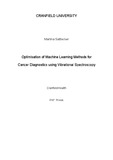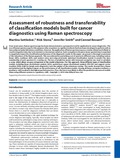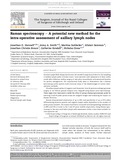JavaScript is disabled for your browser. Some features of this site may not work without it.
| dc.contributor.advisor | Bessant, Conrad | |
| dc.contributor.advisor | Stone, Nicholas | |
| dc.contributor.author | Sattlecker, Martine | |
| dc.date.accessioned | 2011-10-06T13:50:17Z | |
| dc.date.available | 2011-10-06T13:50:17Z | |
| dc.date.issued | 2011-01 | |
| dc.identifier.uri | http://dspace.lib.cranfield.ac.uk/handle/1826/6286 | |
| dc.description.abstract | Early cancer detection drastically improves the chances of cure and therefore methods are required, which allow early detection and screening in a fast, reliable and inexpensive manner. A prospective method, featuring all these characteristics, is vibrational spectroscopy. In order to take the next step towards the development of this technology into a clinical diagnostic tool, classification and imaging methods for an automated diagnosis based on spectral data are required. For this study, Raman spectra, derived from axillary lymph node tissue from breast cancer patients, were used to develop a diagnostic model. For this purpose different classification methods were investigated. A support vector machine (SVM) proved to be the best choice of classification method since it classified 100% of the unseen test set correctly. The resulting diagnostic models were thoroughly tested for their robustness to the spectral corruptions that would be expected to occur during routine clinical analysis. It showed that sufficient robustness is provided for a future diagnostic routine application. SVMs demonstrated to be a powerful classifier for Raman data and due to that they were also investigated for infrared spectroscopic data. Since it was found that a single SVM was not capable of reliably predicting breast cancer pathology based on tissue calcifications measured by infrared micro-spectroscopy a SVM ensemble system was implemented. The resulting multi-class SVM ensemble predicted the pathology of the unseen test set with an accuracy of 88.9%, in comparison a single SVM assessed with the same unseen test set achieved 66.7% accuracy. In addition, the ensemble system was extended for analysing complete infrared maps obtained from breast tissue specimens. The resulting imaging method successfully detected and staged calcification in infrared maps. Furthermore, this imaging approach revealed new insights into the calcification process in malignant development, which was not previously well understood. | en_UK |
| dc.language.iso | en | en_UK |
| dc.publisher | Cranfield University | en_UK |
| dc.rights | © Cranfield University 2011. All rights reserved. No part of this publication may be reproduced without the written permission of the copyright owner. | en_UK |
| dc.title | Optimisation of machine learning methods for cancer detection using vibrational spectroscopy | en_UK |
| dc.type | Thesis or dissertation | en_UK |
| dc.type.qualificationlevel | Doctoral | en_UK |
| dc.type.qualificationname | PhD | en_UK |



